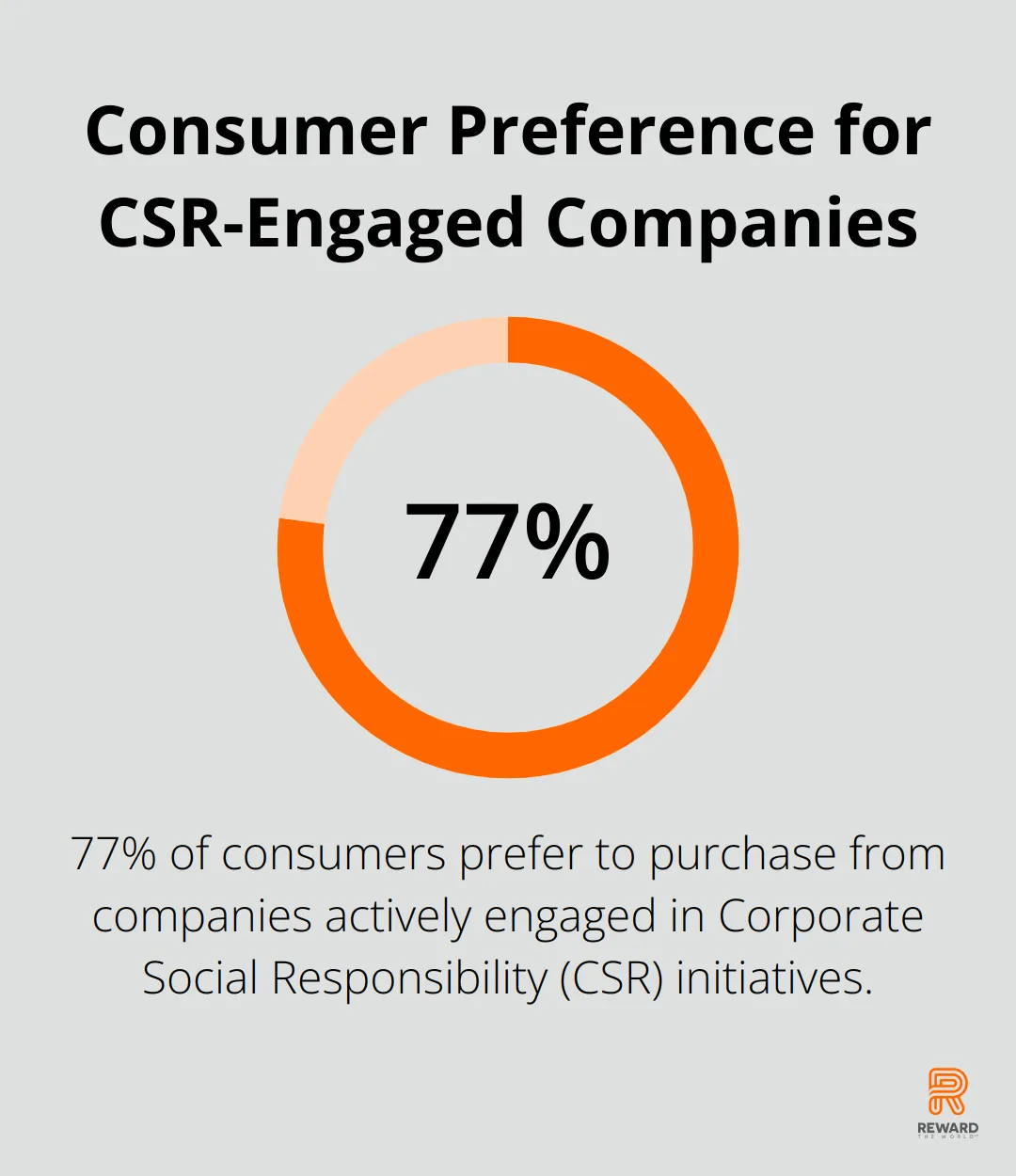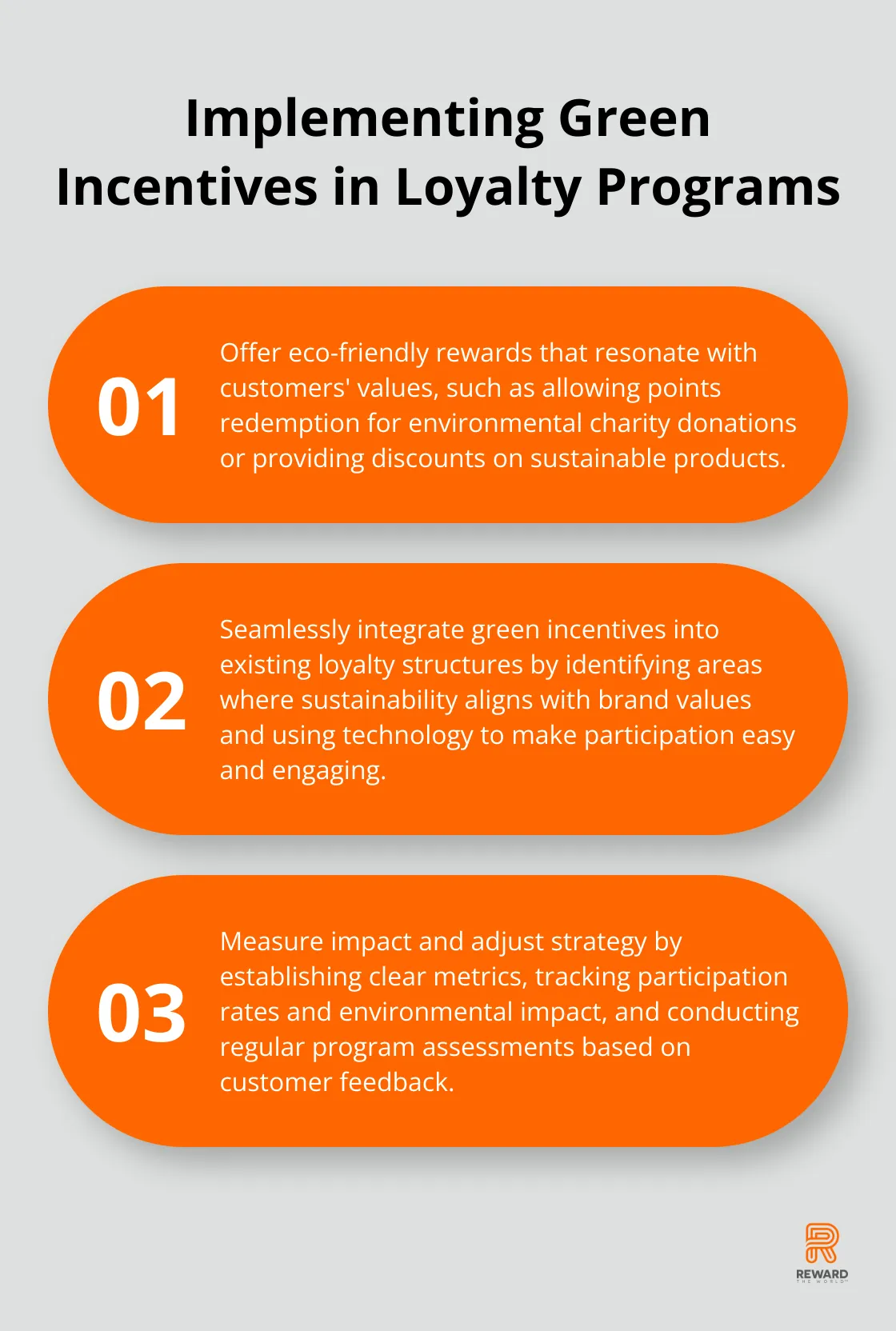
Green incentives are reshaping the landscape of customer loyalty and brand perception. At Reward the World, we’ve seen a surge in businesses adopting eco-friendly practices to meet growing consumer demand for sustainability.
These initiatives not only attract environmentally conscious customers but also significantly boost a company’s image. In this post, we’ll explore how green incentives can transform loyalty programs and elevate brand reputation in today’s eco-aware market.
Why Green Incentives Are Booming
Consumer Demand Drives Change
Green incentives aren’t just a passing trend; they’re transforming supply chains and consumer behavior. It’s a fundamental shift in how businesses operate and how consumers make purchasing decisions.
Recent data shows that products marketed as sustainable are driving significant growth in consumer packaged goods. This statistic alone demonstrates the power of eco-friendly offerings in today’s market.
A global survey in 2025 revealed that 77% of consumers prefer to purchase from companies actively engaged in Corporate Social Responsibility (CSR) initiatives. This preference is even stronger among younger generations, with 62% of Generation Z consumers opting for sustainable brands (according to a survey by First Insight).

Corporate Responsibility Evolves
Businesses take note. Unilever reported that its sustainable living brands grew significantly faster than the rest of its business. This isn’t just good for the planet; it’s good for the bottom line.
Companies now integrate sustainability into their core strategies. For instance, Timberland’s sustainability platform showcases real-time data on their environmental impact (including trees planted). This level of transparency builds trust and loyalty among environmentally conscious consumers.
Successful Green Incentive Programs
H&M’s Garment Collection Program
H&M’s garment collection program exemplifies a successful green incentive. By offering vouchers to customers who bring in old clothes (regardless of the brand), H&M encourages recycling while fostering customer loyalty.
Patagonia’s Worn Wear Program
Patagonia’s Worn Wear program allows customers to trade in used gear for store credit. This not only promotes sustainability but also creates a circular economy within their business model.
Starbucks’ Reusable Cup Initiative
Starbucks has also joined the movement with their reusable cup program, offering discounts to customers who bring their own cups. This simple initiative reduces disposable cup waste and operational costs while rewarding eco-friendly behavior.
These programs show that green incentives can be both environmentally beneficial and economically sound. They create a win-win situation where customers feel good about their choices, and businesses benefit from increased loyalty and positive brand perception.
As the market continues to evolve, businesses must adapt to stay competitive. The next section will explore how companies can implement these green incentives into their existing loyalty programs, creating a powerful tool for customer retention and brand enhancement.
How to Implement Green Incentives in Loyalty Programs
At Reward the World, we observe a significant shift in business approaches to loyalty programs. Green incentives now form the core of customer engagement strategies. Here’s how companies can effectively implement eco-friendly rewards into their loyalty structures.
Eco-Friendly Rewards That Resonate
The success of green incentives hinges on offering rewards that align with customers’ values. REI’s membership program allows customers to allocate dividends to environmental causes, creating a meaningful connection between purchases and positive impact. Similarly, Sephora’s Beauty Insider program enables points redemption for donations to environmental charities.
These examples demonstrate that eco-friendly rewards don’t require complexity. Simple actions (like offering discounts on eco-friendly products) can prove highly effective. Costa Coffee’s loyalty scheme, for instance, rewards customers with extra points for using reusable cups.
Seamless Integration into Existing Programs
Integrating green incentives into existing loyalty structures doesn’t necessitate a complete overhaul. Companies should identify areas where sustainability aligns with their brand values. For example, fashion industry players might consider a program similar to Madewell’s, which offers discounts for trading in old jeans.
Technology can make participation easy. Mobile apps enhance consumer engagement by tracking eco-friendly actions and rewards through gamification. This approach not only makes sustainability fun but also provides valuable data on customer behavior.
Measuring Impact and Adjusting Strategy
To understand the effectiveness of green incentives, businesses must establish clear metrics. They should track not only participation rates but also the environmental impact of customer actions. Timberland’s real-time data on trees planted exemplifies transparent impact reporting.
A 2024 PwC survey indicates that consumers will spend an average of 9.7% more on sustainably sourced goods. Companies should monitor whether their green incentives influence purchasing decisions and adjust their strategy accordingly.
Regular program assessments based on customer feedback prove crucial. This ensures the loyalty program remains relevant and effective. Authenticity is key – customers can spot greenwashing, so green incentives must align genuinely with overall business practices.

The implementation of green incentives in loyalty programs represents more than a trend; it’s a strategic move that can significantly boost customer engagement and brand loyalty. The next chapter will explore how these initiatives can enhance a company’s brand image and differentiate them in an increasingly eco-conscious marketplace.
How Green Initiatives Transform Brand Perception
Building Trust Through Environmental Responsibility
Environmental consciousness has become a mainstream concern. The 2024 Edelman Trust Barometer reveals a new paradox at the heart of society, where rapid innovation offers the promise of a new era of prosperity. This insight underscores the pivotal role sustainability plays in consumer trust.
Patagonia exemplifies this trust-building approach. Their commitment to environmental causes transcends marketing-it’s the core of their business model. By promoting product repair and reuse, they’ve cultivated a reputation for authenticity that deeply resonates with eco-conscious consumers.
Differentiating in a Competitive Landscape
In today’s market, where consumers face an abundance of choices, sustainable practices offer a powerful differentiator. The 2024 Sustainable Market Share Index reveals that products marketed as sustainable now hold an 18.5% market share, up 4.8 percentage points versus 2015. This shift represents more than a trend; it signals a fundamental change in consumer preferences.
Unilever’s experience further illustrates this point. Their sustainable living brands outpaced the rest of the business, growing 69% faster. This remarkable growth demonstrates that sustainability drives business success, not just positive PR.

Leveraging Green Initiatives for Marketing Success
Green initiatives provide a rich source of positive stories for PR and marketing teams. H&M’s garment collection program, for instance, generated significant media coverage and social media buzz. This positive attention enhanced H&M’s brand image and educated consumers about textile recycling.
Timberland’s real-time sustainability dashboard serves as another excellent example. Their transparent sharing of environmental impact (including trees planted and recycled materials used) creates a compelling narrative that resonates with environmentally conscious consumers.
Boosting Employee Engagement Through Sustainability
Green initiatives impact more than external perceptions; they also enhance internal morale. A 2025 Deloitte survey found that without financial security, Gen Zs and millennials are less likely to have a positive sense of well-being and less likely to feel their work has a positive impact. Companies that implement sustainable practices attract top talent and increase employee satisfaction.
Starbucks’ reusable cup program exemplifies an initiative that engages both customers and employees. Baristas become sustainability advocates, creating a ripple effect that extends beyond the store walls.
Green initiatives have become essential for businesses aiming to thrive in today’s market. They serve as powerful tools for building trust, standing out from competitors, and creating positive narratives that resonate with consumers and employees alike. Companies that authentically integrate sustainability into every aspect of their operations will lead the way forward.
Wrapping Up
Green incentives have become a powerful tool for businesses to enhance customer loyalty and elevate their brand image. Companies that embrace sustainability in their loyalty programs see remarkable growth, outpacing their less eco-conscious competitors. As consumer awareness grows and environmental concerns intensify, businesses must innovate further in their sustainability efforts.
The path forward for businesses ready to implement green rewards is clear. Companies should identify areas where sustainability aligns with their brand values and develop rewards that resonate with their target audience. Technology can make participation easy and engaging for customers, while authenticity remains paramount in any approach.
At Reward the World, we offer a turnkey solution for companies looking to implement eco-friendly rewards programs. Our platform helps businesses create impactful green incentives that drive loyalty and enhance brand image. The shift towards sustainability represents a fundamental change in business operations and consumer decision-making, positioning companies at the forefront of this transformation.
